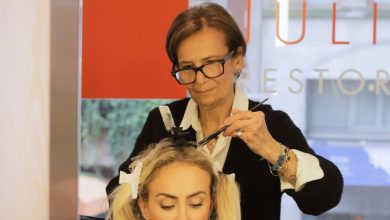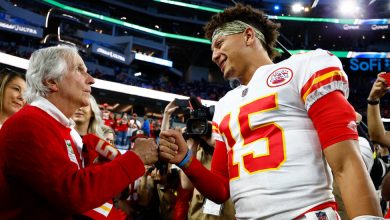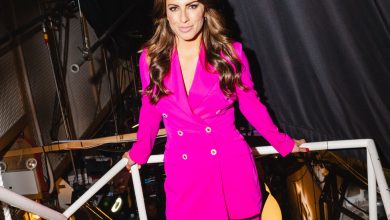Moving Through the Lens

Like many successful romances, the one between the model and photographer Guinevere van Seenus and the writer and podcaster Beau Friedlander had a middle man: Ms. van Seenus’s three-legged dog, Ashley.
“He was just the weird guy at the dog park,” Ms. van Seenus, 45, teasingly recalled of her first encounter with Mr. Friedlander five years ago. She was sitting at the dining table of the Connecticut farmhouse that she and Mr. Friedlander bought together last year. Ashley — a so-called Velcro dog, uninterested in anyone except her owner — had taken an instant liking to Mr. Friedlander and his two dogs.
“She started waiting for Beau and his dogs,” Ms. van Seenus. said. “She would sit on the top of the picnic bench looking at the road to see if they were going to come. It became her obsession.”
“I had a crush on you,” said Mr. Friedlander, 52, who also claims to “speak dog.” He didn’t know Ms. van Seenus was a model. He began clocking what time she showed up at the park each morning. “I guess nowadays, they’d call that stalking,” he joked.
As neighbors, the two struck up an uncertain friendship. “We texted each other pretty much every morning two words: ‘Dog park?’” Mr. Friedlander said. “I would get down there even if I was busy.” Ms. van Seenus had an on-again-off-again boyfriend. Mr. Friedlander tried not to mind. He drove her to the airport when she had to fly to Europe for work. He made her lunch, doodling cartoons of its contents on the paper bag. He took up gardening when she showed an interest in horticulture. He invited her and her friend over for dinner. His two daughters told him his chances were hopeless.
One night, Ms. van Seenus cut her finger on broken glass while doing the dishes. Thinking she might have to go the hospital, she realized she would have called Mr. Friedlander — and not her boyfriend. “I thought, ‘You’re dating the wrong person,’” she said.
Not too much later — after a platonic year and a half together — the relationship became romantic.
“Now we’re house married,” Mr. Friedlander said. The couple’s 1911 house, which was bought in a dilapidated state, has become their biggest project in their spare time. Their three dogs were huddled together around the hearth. Proper heating and insulation had yet to be completed.
“And animal married,” Ms. van Seenus added with a smile.
A New Chapter
If, in the last few years, Ms. van Seenus has found love, she has also quietly stepped out as a photographer. Last month, the denim brand Agolde announced that Ms. van Seenus had shot (with a series of self-portraits) its latest campaign — her first behind the lens. Recent photographs Ms. van Seenus has taken of herself and of her family and friends, including the photographer Yelena Yemcheck and the models Kirsten Owen and Saskia de Brauw, have appeared in German Vogue, Vogue Czechoslovakia and niche publications like Purpose and Perspective and Self Service Magazine. Ms. van Seenus posts much of this work on her Instagram accounts @guineverevanseenus and @just_film_by_gvs.
“She has her camera on her all the time,” Ms. Yemcheck, 51, said. “When she comes over for dinner, she brings her camera.”
It’s a welcome second act for a model whose career in the late 1990s reached stratospheric heights. Ms. van Seenus has worked with almost every giant in the industry, including Karl Lagerfeld, Richard Avedon and Irving Penn. She has appeared in advertising campaigns for almost every fashion designer imaginable, from Alexander McQueen to Versace. She has been featured on multiple covers of Italian Vogue, W Magazine, and in the pages of virtually every major magazine.
Born in 1976 in Brookline, Mass., Ms. van Seenus grew up in Washington, D.C., before her family moved to Santa Barbara, Calif., when she was 13. Her parents, Dutch immigrants and hippies, were pioneers of the health food craze. They opened several natural food supermarkets around the United States.
As a teenager, Ms. van Seenus was crafty and artistic, even sewing her own prom dress. A natural athlete, she liked playing basketball. After a growth spurt, she tried modeling at the suggestion of her mother. The opportunities in Southern California were limited for someone like Ms. van Seenus. “The market in L.A. in the early ’90s was ‘Baywatch,’ that was it,” she said.
Everything changed when she landed in Europe in 1995 at the age of 18. At the time, fashion was experiencing a profound shift. Models like Kate Moss and Kristen McMenamy were disrupting the idea that the supermodel (think: Cindy Crawford, Linda Evangelista or Claudia Schiffer) had to be conventionally sexy in order to be successful. A model didn’t have to represent outsize glamour and beauty anymore. There was an interest in women who seemed more accessible, whose beauty seemed paired with a kind of intelligence.
“Suddenly, ‘glamour’ and ‘power’ weren’t the only words being used,” said the designer Marc Jacobs, 58, who first worked with Ms. van Seenus in 1996, after famously introducing grunge to the runway in 1993. “It was about beauty, fragility, poetry. Fashion was opening up to alternative ideas of aesthetics.”

Ms. van Seenus is transitioning to a career in photography after 30 years as a model.Credit…Jody Rogac for The New York Times
Ms. van Seenus — with her alabaster skin, haunting blue eyes and more shapely physique — conveyed a different sensibility.
“You had to be 5’10 and bone thin and blah blah blah, and Guinevere showed up,” said Dawn Wolf, 67, a model agent who worked with Ms. van Seenus in those years. “She’s like the Antichrist. She was that spark.”
After trudging through casting after casting with little to no success, Ms. van Seenus was suddenly in demand. “Everything took off so fast it was hard to keep up, to be honest,” she said.
Photographers found her an inspiration. “She’s like the Venus de Milo to me,” said the photographer Paolo Roversi, 74, whose pictures of Ms. van Seenus for Yohji Yamamoto’s catalogs of that era have become collectors’ items.
“I’d never seen a face like Guinevere’s,” recalled the photographer Craig McDean, 58. “It was so beautiful. It was almost like porcelain, like a doll. I used to go to a lot of museums back then and look at all the Pre-Raphaelite paintings. She reminded me of them.”
“She looks like a woman out of a Renaissance painting or a Greek sculpture,” said the photographer Mario Sorrenti, 50.
In 1996, Ms. van Seenus was cast for the Jil Sander spring campaign. Shot by Mr. McDean, Ms. van Seenus is depicted wearing very little makeup, her hair is gently trussed on top of her head, and her eyebrows are bleached. The designer’s clothes are barely visible. Yet there was a softness to the picture. It spoke to a type of woman who wasn’t interested in going to the beauty parlor to look great, who didn’t want to wear a full face of makeup with a nice dress.
“She exuded wisdom and strength in that picture,” said the designer Rachel Comey, 49, who has worked with Ms. van Seenus before and recently featured the model in her latest spring campaign. “Suddenly fashion was no longer rich people, luxury and glamour — there was an artfulness to it.”
That same year, 1996, Ms. van Seenus was nominated to be the supermodel of the year by VH1. Rolling Stone magazine featured her on its Hot List, and Women’s Wear Daily named her the most visible model of the season.
But with the career highs came more personal lows. After just two very intense years of success, Ms. van Seenus was struggling to find a balance between work and life. An introvert, she didn’t date much and was uninterested in going to parties or fashion events.
Her world outside of the industry was diminishing. She said: “I never wanted to say no to work. I was really lucky. Every time Paolo Roversi or Craig McDean or Steven Meisel would call, it would be a yes for sure. And then, runway shows take up a good portion of the year, and pretty soon you’re working Christmas Eve, Christmas Day, Thanksgiving, not seeing your family.”
She paused. “Yeah, I didn’t pace myself very well.”
Ms. van Seenus began experiencing crippling anxiety and depression. It got so bad that she couldn’t get out of bed. “It stopped my life entirely,” she said. She needed an out. In 1997, she decided to leave modeling and moved to Woodstock, N.Y., before ending up in Los Angeles in 2001, where she enrolled in Santa Monica College to study art.
A Reclamation
At the dining table, Ms. van Seenus shared her personal collection of the test Polaroids taken of her throughout her career. There’s one by David Sims, another by David LaChapelle. Mr. Friedlander affectionately referred to these younger versions of Ms. van Seenus as “Baby G.”
Ms. van Seenus entered the industry as a teenager. Soon, her body began to change. No matter how much she worked out, how skinny she could whittle down her frame, her hips were still considered big, her breasts full. In one early test Polaroid, Ms. van Seenus wears a bikini. Her ribs are strikingly visible.
“I remember, they couldn’t run it,” she said. She noted that the endless commentary the industry made about your body — this part of you is too big, that part of you is too small — could be exhausting in its contradictions.
“All of sudden, you feel like you have no protective barrier in the world,” Ms. van Seenus said. “You’re supposed to be available to people. You want to protect yourself and it starts to be this battle.”An imperfect vegan — “I do my best,” she said — Ms. van Seenus has also refused to model fur, which was once perceived as a limitation.
Today, she is grateful that the modeling world seems to be more open to the idea of longevity.
“I think we’ve gotten better at embracing — and I see this as being part of the #MeToo movement and other conversations around inclusivity — the different phases of being a woman,” she said. “It’s not how skinny you can be from age 16 to 20. If you get a great girl, it’s about her at 50, at 60. It’s not about keeping her quiet, it’s about letting her speak for herself or the environment or women’s rights. The game has completely changed.”
Art school, then, became another way of finding herself. Ms. van Seenus took classes in photography, ceramics, printing, theater makeup and more. “Figure drawing was a beautiful experience,” she said. “It allowed me to really appreciate a woman’s body again.”
She began showing the jewelry she had been making, intricate headpieces, collars and gloves hand knit out of metal, beads and semiprecious and precious stones. Pieces from her line, Cootje — a Dutch nickname for her paternal grandmother, Jacoba — have been featured in Vogue.
Throughout the 2000s, the fashion world kept calling. Modeling — even at her discretion — made it difficult to finish her coursework. In 2015, she moved to New York City to pursue both fashion and school, and she began studying at the International Center of Photography. Being on set, however, had always been its own form of education for her.
“She asked me once if she could come in and sit with my assistants to do Photoshop,” Mr. McDean said.
Marc Ascoli, the founder and creative director of Atelier 32, said: “She was always curious. She asked questions.”
“I really did pick jobs based on creativity and not based on money,” Ms. van Seenus said. “I had agents who were like, ‘Are you crazy. You’re going to regret this later.’ They’re not wrong. Do I wish I had amassed the amounts of money I could have? Yeah. But I was always so much more invigorated by the jobs that were about being creative.”
Today, Ms. van Seenus is more comfortable calling herself an artist, which is perhaps what she has been this whole time. She said she is shy and that she can be something of a perfectionist. It can be hard to know when to stop or how to trust herself. The artistic process — with its own mania, insecurities and doubts — is something she’s still becoming accustomed to, as well working on a deadline.
Like many of the great photographers she has worked with, she prefers film, and is fond of shooting with a Twin-Lens Rolleiflex or a Leica MC. Polaroid remains her favorite. “You get what you get,” she said. “Everything else can change in processing and Photoshop, but with Polaroid, it’s the one true version. You don’t have full control.” (In another form of expression, Ms. van Seenus also embroiders her Polaroids with beads.) Mr. Friedlander is an encouraging partner, who proudly champions her work. Both he and his two daughters have become subjects under Ms. van Seenus’s gaze.
“I love that she’s turning the lens on herself,” said Karen Elson, 43, who recalled that Ms. van Seenus helped pave the way for her as young model. “It’s reclaiming a part of herself from all these years of being the ‘muse’ — and I use that word reluctantly. What I like is that she’s taking ownership of that space.”
But when Ms. van Seenus was told what many of her peers have said about her, including Mr. Meisel, who considers her “a true artist,” she remained bashful.
“I’m just lucky I found my tribe,” she said.





